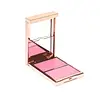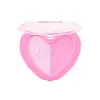What's inside
What's inside
 Key Ingredients
Key Ingredients

 Benefits
Benefits

 Concerns
Concerns

 Ingredients Side-by-side
Ingredients Side-by-side

Phenyl Trimethicone
Skin ConditioningDipentaerythrityl Hexahydroxystearate/Hexastearate/Hexarosinate
Skin ConditioningEthylhexyl Stearate
EmollientTriisostearyl Citrate
EmollientDiisostearyl Malate
EmollientPolyethylene
AbrasivePolybutene
Silica
AbrasiveVinyl Dimethicone/Methicone Silsesquioxane Crosspolymer
Nylon-12
Disteardimonium Hectorite
StabilisingOctyldodecanol
EmollientPropylene Carbonate
SolventPentaerythrityl Tetra-Di-T-Butyl Hydroxyhydrocinnamate
AntioxidantTocopheryl Acetate
AntioxidantParfum
MaskingBenzyl Salicylate
PerfumingFarnesol
PerfumingLinalool
PerfumingTitanium Dioxide
Cosmetic ColorantIron Oxides
CI 45410
Cosmetic ColorantCI 73360
Cosmetic ColorantCI 19140
Cosmetic ColorantMica
Cosmetic ColorantMagnesium Myristate
Octyldodecyl Stearoyl Stearate
EmollientGlyceryl Triacetyl Ricinoleate
EmollientCaprylic/Capric Triglyceride
MaskingPEG-12 Dimethicone
Skin ConditioningPolyhydroxystearic Acid
EmulsifyingTrimyristin
Skin ConditioningPotassium Sorbate
PreservativeCaprylyl Glycol
EmollientBenzotriazolyl Dodecyl P-Cresol
UV AbsorberPhenoxyethanol
PreservativeHydrogenated Phosphatidylcholine
EmulsifyingHexylene Glycol
EmulsifyingTin Oxide
AbrasiveTriethoxycaprylylsilane
CI 77163
Cosmetic ColorantCI 75470
Cosmetic ColorantCI 15850
Cosmetic ColorantCI 16035
Cosmetic ColorantCI 77007
Cosmetic ColorantPhenyl Trimethicone, Dipentaerythrityl Hexahydroxystearate/Hexastearate/Hexarosinate, Ethylhexyl Stearate, Triisostearyl Citrate, Diisostearyl Malate, Polyethylene, Polybutene, Silica, Vinyl Dimethicone/Methicone Silsesquioxane Crosspolymer, Nylon-12, Disteardimonium Hectorite, Octyldodecanol, Propylene Carbonate, Pentaerythrityl Tetra-Di-T-Butyl Hydroxyhydrocinnamate, Tocopheryl Acetate, Parfum, Benzyl Salicylate, Farnesol, Linalool, Titanium Dioxide, Iron Oxides, CI 45410, CI 73360, CI 19140, Mica, Magnesium Myristate, Octyldodecyl Stearoyl Stearate, Glyceryl Triacetyl Ricinoleate, Caprylic/Capric Triglyceride, PEG-12 Dimethicone, Polyhydroxystearic Acid, Trimyristin, Potassium Sorbate, Caprylyl Glycol, Benzotriazolyl Dodecyl P-Cresol, Phenoxyethanol, Hydrogenated Phosphatidylcholine, Hexylene Glycol, Tin Oxide, Triethoxycaprylylsilane, CI 77163, CI 75470, CI 15850, CI 16035, CI 77007
Talc
AbrasiveMica
Cosmetic ColorantSilica
AbrasiveTitanium Dioxide
Cosmetic ColorantOctyldodecyl Stearoyl Stearate
EmollientPhenyl Trimethicone
Skin ConditioningMagnesium Myristate
Methylpropanediol
SolventTriethoxycaprylylsilane
Diisostearyl Malate
EmollientDipentaerythrityl Hexahydroxystearate/Hexastearate/Hexarosinate
Skin ConditioningPropanediol
SolventDimethicone
EmollientHydrogenated Lecithin
EmulsifyingAluminum Hydroxide
EmollientCI 45410
Cosmetic ColorantUltramarines
CI 19140
Cosmetic ColorantTalc, Mica, Silica, Titanium Dioxide, Octyldodecyl Stearoyl Stearate, Phenyl Trimethicone, Magnesium Myristate, Methylpropanediol, Triethoxycaprylylsilane, Diisostearyl Malate, Dipentaerythrityl Hexahydroxystearate/Hexastearate/Hexarosinate, Propanediol, Dimethicone, Hydrogenated Lecithin, Aluminum Hydroxide, CI 45410, Ultramarines, CI 19140
Ingredients Explained
These ingredients are found in both products.
Ingredients higher up in an ingredient list are typically present in a larger amount.
CI 19140 is also known as Tartrazine. Tartrazine is a synthetic dye used in cosmetics, foods, and medicine to add a yellow color.
Tartrazine is created from petroleum and is water-soluble.
Some people may experience allergies from this dye, especially asthmatics and those with an aspirin intolerance.
Learn more about CI 19140CI 45410 is a synthetic red-pigment and dye.
It often goes by both Red 28 or Red 27; manufacturers label both ingredients as CI 45410.
This dye is commonly found in makeup because it imparts a vivid color. Some types of this dye change color based on pH level and interaction with moisture:
Your skin has a natural pH of around 4.5 - 5.5.
According to the FDA, CI 45410 is not permitted for use in eye products.
Red 27 is a flourescein dye and commonly used as a fluorescent tracer in medicine.
Learn more about CI 45410Diisostearyl Malate is an emollient and most often used in lip products. It comes from isostearyl alcohol, a fatty acid, and malic acid, an AHA.
As an emollient, Diisostearyl Malate helps create a thin film on your skin to trap moisture in. This helps keep your skin soft and smooth.
We don't have a description for Dipentaerythrityl Hexahydroxystearate/Hexastearate/Hexarosinate yet.
We don't have a description for Magnesium Myristate yet.
Mica is a naturally occurring mineral used to add shimmer and color in cosmetics. It can also help improve the texture of a product or give it an opaque, white/silver color.
Serecite is the name for very fine but ragged grains of mica.
This ingredient is often coated with metal oxides like titanium dioxide. Trace amounts of heavy metals may be found in mica, but these metals are not harmful in our personal products.
Mica has been used since prehistoric times throughout the world. Ancient Egyptian, Indian, Greek, Roman, Aztec, and Chinese civilizations have used mica.
Learn more about MicaOctyldodecyl Stearoyl Stearate is created from stearic acid.
It is an emollient and thickens the lipid (oil) portion of a product. Due to its emollient properties, it may not be fungal-acne safe.
Phenyl Trimethicone is a silicon-based polymer. It is derived from silica.
Phenyl Trimethicone is used as an emollient and prevents products from foaming.
As an emollient, it helps trap moisture in the skin. It is considered an occlusive.
Learn more about Phenyl TrimethiconeSilica, also known as silicon dioxide, is a naturally occurring mineral. It is used as a fine, spherical, and porous powder in cosmetics.
Though it has exfoliant properties, the function of silica varies depending on the product.
The unique structure of silica enhances the spreadability and adds smoothness, making it a great texture enhancer.
It is also used as an active carrier, emulsifier, and mattifier due to its ability to absorb excess oil.
In some products, tiny microneedles called spicules are made from silica or hydrolyzed sponge. When you rub them in, they lightly polish away dead skin layers and enhance the penetration of active ingredients.
Learn more about SilicaTitanium dioxide is a mineral UV filter widely used in sunscreens and cosmetics.
It is one of only two UV filters officially classified as “mineral” by regulatory agencies, the other being zinc oxide.
Titanium dioxide provides broad-spectrum protection mostly in the UVB and UVAII range, with some protection in the UVAI range.
While its UVA protection isn’t as strong as zinc oxide’s, the difference is minor.
A common myth is that mineral UV filters reflect UV light. However, modern research shows titanium dioxide absorbs UV radiation like chemical filters (~95% absorption & 5% reflection).
Thanks to its non-irritating nature, titanium dioxide is suitable for sensitive, acne-prone, or redness-prone skin. It is unlikely to cause "eye sting" like other sunscreen ingredients.
A major drawback of this ingredient is its white cast and thick texture. This is why mineral sunscreens often leave a white cast and are less cosmetically elegant than chemical/hybrid sunscreens.
To improve white cast and spreadability, micronized or nano-sized titanium dioxide is often used.
There are ongoing concerns surrounding nano-titanium oxide's impact on marine ecosystems.
There is no conclusive evidence that any form of titanium oxide (or any other sunscreen ingredients) will cause harm to marine ecosystems or coral reefs. The science is still developing but many consumers are keeping a close eye on this issue.
Please note, many destinations have reef-safety sunscreen rules. For instance, the U.S. Virgin Islands advises all visitors to use non-nano mineral sunscreens.
Nano mineral sunscreens once raised safety concerns about absorption into skin.
Extensive research has shown that they do not penetrate healthy or damaged skin; they remain safely on the surface and the top layer of dead skin (stratum corneum).
You'll likely find titanium dioxide bundled with alumina, silica, or dimethicone. These ingredients help make titanium dioxide highly photostable; this prevents it from interacting with other formula components under UV light.
Learn more about Titanium DioxideTriethoxycaprylylsilane is a silicone used to bind and stabilize ingredients.
As an emulsifier, it helps prevent ingredients from separating. This can help elongate the shelf life of products.
Triethoxycaprylylsilane is often used to coat mineral sunscreens ingredients to help give a better feel. It also helps reduce oxidative stress in sunscreens.
Learn more about Triethoxycaprylylsilane